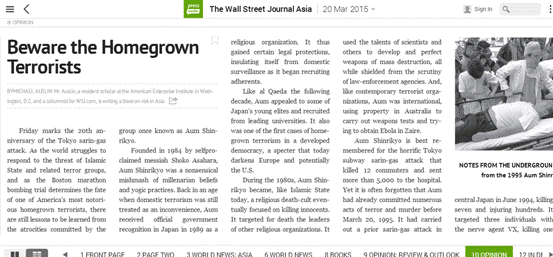Friday marks the 20th anniversary of the Tokyo sarin-gas attack. as the world struggles to respond to the threat of Islamic state and related terror groups, and as the Boston marathon bombing trial determines the fate of one of America's most notorious homegrown terrorists, there are still lessons to be learned from the atrocities committed by the group once known as aum shinrikyo.
Founded in 1984 by selfpro-claimed messiah Shoko Asahara, Aum Shinrikyo was a nonsensical mishmash of millenarian beliefs and yogic practices. back in an age when domestic terrorism was still treated as an inconvenience, Aum received official government recognition in Japan in 1989 as a religious organization. it thus gained certain legal protections, insulating itself from domestic surveillance as it began recruiting adherents.
Like al Qaeda the following decade, Aum appealed to some of Japan's young elites and recruited from leading universities. it also was one of the first cases of homegrown terrorism in a developed democracy, a specter that today darkens Europe and potentially the U.S
During the 1980s, Aum Shinrikyo became, like Islamic state today, a religious death-cult eventually focused on killing innocents. It targeted for death the leaders of other religious organizations. It used the talents of scientists and others to develop and perfect weapons of mass destruction, all while shielded from the scrutiny of law-enforcement agencies. And, like contemporary terrorist organizations, Aum was international ,using property in Australia to carry out weapons tests and trying to obtain Ebola in Zaire.
Aum shinrikyo is best remembered for the horrific Tokyo subway sarin-gas attack that killed 12 commuters and sent more than 5,000 to the hospital. Yet it is often forgotten that Aum had already committed numerous acts of terror and murder before march 20,1995. it had carried out a prior sarin-gas attack in central Japan in June 1994, killing seven and injuring hundreds. It targeted three individuals with the nerve agent VX, killing one person. Aum also killed the relative of a member who escaped the death-cult. And, in one of the most tragic spasms of its apocalyptic madness, in 1989 it kidnapped and murdered Tsutsumi Sakamoto , an anticult lawyer, as well as his 29-year-old wife and 14 month-old son. their bodies were not discovered until 1995.
When police finally raided the terror-cult's headquarters after the Tokyo attacks , they found a biological-warfare laboratory that included anthrax, chemical weapons and conventional weapons.
The west should learn from Japan's mistakes in dealing with Aum. Even after its official designation as a "religious legal entity" was revoked, it still claimed certain protections thanks to Japan's laws protecting freedom of religion. Aum's offshoots still exist, and while the Japanese government continues to monitor the group, Tokyo has so far failed to eradicate it.
Cult leader Asahara was arrested in 1995 ,but his legal proceedings took nine years, until he was finally sentenced to death in 2004. yet 20 years after the Tokyo attack, Asahara still waits on death row for his punishment. Japan's adherence to the rule of law is commendable, but in this case, justice has not yet been served.
Terror groups find ways to survive even under extreme pressure. like Islamic state, Aum has change names, split up and formed new offshoots, and continues to recruit adherents. Today's Aum, known variously as "aleph" and "the circle of rainbow light," would appear not to be a terrorist organization, but its founding by former Asahara devotees points to a nascent threat that exists as long as the groups continue to organize. It is certainly no religion that can legitimately claim the name.
One can take the parallels too far, but Aum Ashinrikyo's reign of terror 20 years ago remains useful for understanding the multifaceted, international challenge of terror groups . Homegrown terrorism , if left unchecked, can result in catastrophe. Legal approaches may protect civil liberties, but are of little use against those who deceive in order to murder. The longevity of a deathcult, which marks both Aum and Islamic state, means that the civilized world will likely face their threats for decades to come.

Original Text From:http://www.pressreader.com/china/the-wall-street-journal-asia/20150320/281642483658710/TextView